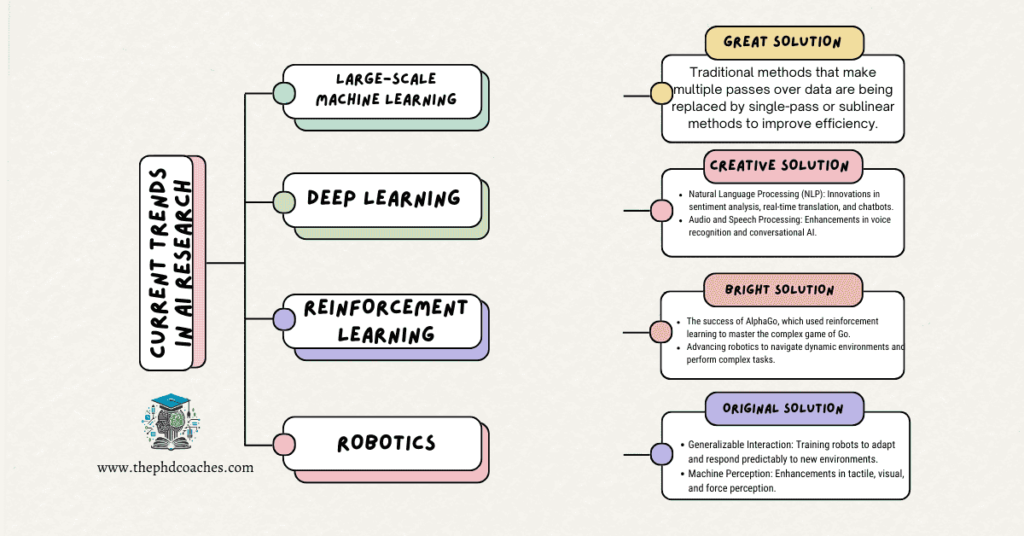
Artificial Intelligence (AI) has evolved from a theoretical concept to a transformative force driving innovation across industries. With breakthroughs in machine learning, robotics, natural language processing, and neuromorphic computing, AI research is advancing at a rapid pace. This blog explores the latest AI research trends, shedding light on their significance, current focus areas, and future potential.
A Shift Towards Human-Aware and Trustworthy AI
Over the past 15 years, AI has transitioned from fulfilling theoretical promises to becoming a central force in society. Today, the focus has shifted from merely creating intelligent systems to designing human-aware, trustworthy AI that integrates seamlessly into our lives.
Key Drivers of the AI Revolution
Scaling machine learning algorithms to handle massive datasets is a pressing challenge. Traditional methods that make multiple passes over data are being replaced by single-pass or sublinear methods to improve efficiency. These advancements are critical for real-time applications like fraud detection and personalized recommendations.
Deep learning continues to redefine fields such as:
Reinforcement learning focuses on decision-making by learning from sequential actions. Its practical applications include:
AI-driven robotics research emphasizes:
1. Natural Language Processing (NLP)
AI’s ability to understand and generate human language is improving rapidly. Key trends include:
Developing dialog-based systems for richer human interactions.
Enhancing voice-based search and communication, as 20% of mobile queries are now voice-activated.
2. Collaborative Systems
AI is being designed to collaborate with humans and other systems. Research focuses on:
Formalizing models of collaboration.
Leveraging human strengths to complement AI capabilities.
3. Crowdsourcing and Human Computation
AI research increasingly integrates human intelligence to solve problems that computers struggle with. Examples include:
Platforms like Wikipedia for knowledge aggregation.
Citizen science projects and services like Amazon Mechanical Turk for labeled training data.
1. Algorithmic Game Theory and Computational Social Choice
Research in this area explores incentive structures in systems involving human and AI participants. Applications include:
Designing mechanisms for truthful reporting in prediction markets.
Improving network games and economic equilibria.
2. Internet of Things (IoT)
AI plays a pivotal role in managing and analyzing data from interconnected devices. The focus is on:
Enhancing compatibility between diverse communication protocols.
Extracting actionable insights from sensory data across devices.
1. Neuromorphic Computing
Neuromorphic systems mimic biological neural networks to improve the efficiency and robustness of AI computations. While still in its early stages, this field holds potential for:
Faster training of deep neural networks.
Reducing energy consumption in AI applications.
2. Human-Aware AI
As AI becomes ubiquitous, the emphasis on creating systems that prioritize safety, trust, and ethical considerations grows. Research includes:
Developing algorithms for bias detection and fairness.
Ensuring transparency in decision-making processes.
The next decade will see AI embedding deeper into daily life, from healthcare and education to urban planning and entertainment. Trends to watch include:
Explainable AI (XAI): Enhancing AI’s transparency and interpretability.
AI in Healthcare: Innovations in diagnostics, drug discovery, and personalized medicine.
Sustainable AI: Reducing the environmental impact of AI computations.
AI research faces challenges, including:
Ensuring data privacy and ethical governance.
Addressing the socioeconomic impact of automation on jobs.
Governments and organizations must:
Develop frameworks for ethical AI deployment.
Invest in AI education to prepare the workforce for future demands.
Encourage interdisciplinary collaboration to address societal challenges.
AI research is at the forefront of technological innovation, reshaping industries and everyday life. From deep learning and robotics to collaborative systems and neuromorphic computing, the field is advancing rapidly. Staying informed about these trends is essential for leveraging AI’s potential responsibly and effectively.
As we move toward a future powered by human-aware and trustworthy AI, collaboration between researchers, policymakers, and the public will be key to maximizing its benefits while mitigating its risks.
1. What are the main trends in AI research?
Key trends include large-scale machine learning, deep learning, reinforcement learning, robotics, and NLP.
2. Why is reinforcement learning significant?
Reinforcement learning enables AI to make decisions and learn from interactions, advancing fields like robotics and game theory.
3. What is neuromorphic computing?
Neuromorphic computing mimics biological neural networks to improve the efficiency and robustness of AI systems.
4. How is AI impacting IoT?
AI analyzes data from interconnected devices, improving automation, efficiency, and compatibility across platforms.
5. What challenges does AI research face?
Key challenges include ensuring data privacy, addressing bias, and managing the socioeconomic impact of automation.

Dr. Chopra is the founder and editor of thephdcoaches.blogs and Thephdcoaches Learn more about her here and connect with her on Instagram, Facebook and LinkedIn.
Dr. Tripti Chopra, founder of The PhD Coach, is an award-winning mentor and leader in integrating AI into academic research, with over a decade of experience guiding PhD students and researchers. Her work revolutionizes research processes, promotes sustainable writing practices, and inspires scholars to embrace technological advancements.
Copyright© 2023 Thephdcoach All rights reserved.
Leave a Comment